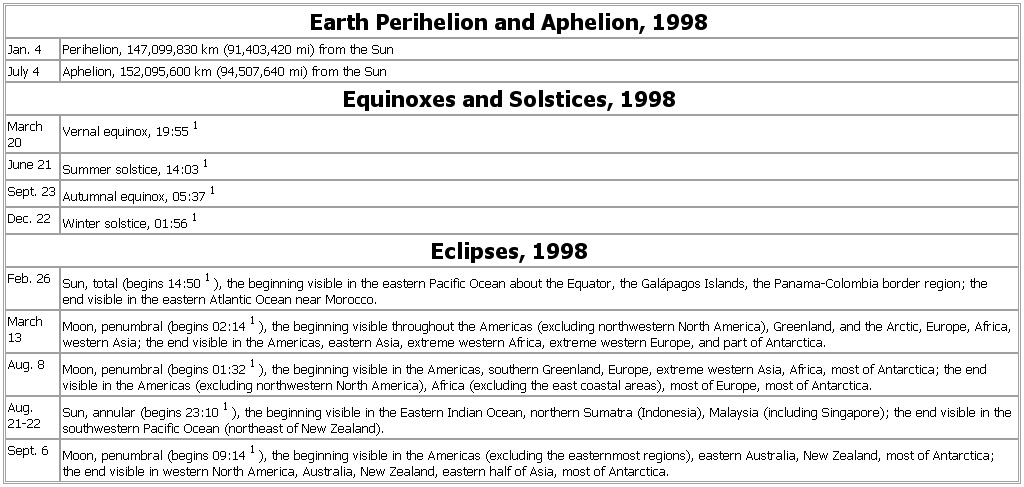Earth Perihelion and Aphelion, 1998
- Earth Perihelion and Aphelion, 1998
-
Earth Perihelion and Aphelion, 1998
Jan. 4 Perihelion, 147,099,830 km (91,403,420 mi) from the Sun
July 4 Aphelion, 152,095,600 km (94,507,640 mi) from the Sun
Equinoxes and Solstices, 1998
March 20 Vernal equinox, 19:551
June 21 Summer solstice, 14:031
Sept. 23 Autumnal equinox, 05:371
Dec. 22 Winter solstice, 01:561
Eclipses, 1998
Feb.
26 Sun,
total (
begins 14:501),
the beginning visible in the eastern Pacific Ocean about the Equator,
the Galápagos Islands,
the Panama-
Colombia border region;
the end visible in the eastern Atlantic Ocean near Morocco.
March 13 Moon,
penumbral (
begins 02:141),
the beginning visible throughout the Americas (
excluding northwestern North America),
Greenland,
and the Arctic,
Europe,
Africa,
western Asia;
the end visible in the Americas,
eastern Asia,
extreme western Africa,
extreme western Europe,
and part of Antarctica.
Aug.
8 Moon,
penumbral (
begins 01:321),
the beginning visible in the Americas,
southern Greenland,
Europe,
extreme western Asia,
Africa,
most of Antarctica;
the end visible in the Americas (
excluding northwestern North America),
Africa (
excluding the east coastal areas),
most of Europe,
most of Antarctica.
Aug.
21-
22 Sun,
annular (
begins 23:101),
the beginning visible in the Eastern Indian Ocean,
northern Sumatra (
Indonesia),
Malaysia (
including Singapore);
the end visible in the southwestern Pacific Ocean (
northeast of New Zealand).
Sept.
6 Moon,
penumbral (
begins 09:141),
the beginning visible in the Americas (
excluding the easternmost regions),
eastern Australia,
New Zealand,
most of Antarctica;
the end visible in western North America,
Australia,
New Zealand,
eastern half of Asia,
most of Antarctica.
See as table:
1Universal time.
Source: The Astronomical Almanac for the Year 1998 (1997).
* * *
Universalium.
2010.
Look at other dictionaries:
Earth Perihelion and Aphelion, 1999 — ▪ 1999 Earth Perihelion and Aphelion, 1999 Jan. 3 Perihelion, 147,096,800 km (91,404,200 mi) from the Sun July 6 Aphelion, 152,098,500 km (94,509,500 mi) from the Sun Equinoxes and Solstices, 1999 March 21 Vernal equinox, 01:461 June 21 Summer… … Universalium
Mathematics and Physical Sciences — ▪ 2003 Introduction Mathematics Mathematics in 2002 was marked by two discoveries in number theory. The first may have practical implications; the second satisfied a 150 year old curiosity. Computer scientist Manindra Agrawal of the… … Universalium
Earth — This article is about the planet. For other uses, see Earth (disambiguation). Earth … Wikipedia
Near-Earth object — Asteroid 4179 Toutatis is a potentially hazardous object that has passed within 2.3 lunar distances … Wikipedia
Physical Sciences — ▪ 2009 Introduction Scientists discovered a new family of superconducting materials and obtained unique images of individual hydrogen atoms and of a multiple exoplanet system. Europe completed the Large Hadron Collider, and China and India took… … Universalium
Near-Earth asteroid — Near Earth asteroids (NEAs) are asteroids whose orbits are close to Earth s orbit. All near Earth asteroids spend part of their orbits between 0.983 and 1.3 astronomical units away from the Sun. Some near Earth asteroids orbits intersect Earth s… … Wikipedia
(101429) 1998 VF31 — Discovery[1] Discovered by LINEAR Discovery site Socorro, New Mexico Discovery date November 13, 19 … Wikipedia
(12538) 1998 OH — Infobox Planet | minorplanet = yes | width = 25em | bgcolour = #FFFFC0 name=(12538) 1998 OH discovery=yes discovery ref= [http://cfa www.harvard.edu/iau/lists/NumberedMPs.html] discoverer=NEAT discovered=1998 07 19 alt names= none mp… … Wikipedia
Apsis — For the architectural term, see Apse. Aphelion and Perihelion redirect here. For Edenbridge s Album, see Aphelion (album). Apogee and Perigee redirect here. For the literary journal, see Perigee: Publication for the Arts. For other uses, see… … Wikipedia
Milankovitch cycles — Past and future Milankovitch cycles. VSOP allows prediction of past and future orbital parameters with great accuracy. ε is obliquity (axial tilt). e is eccentricity. ϖ is longitude of perihelion. esin(ϖ) is the precession index, which together… … Wikipedia
 1Universal time.Source: The Astronomical Almanac for the Year 1998 (1997).
1Universal time.Source: The Astronomical Almanac for the Year 1998 (1997).